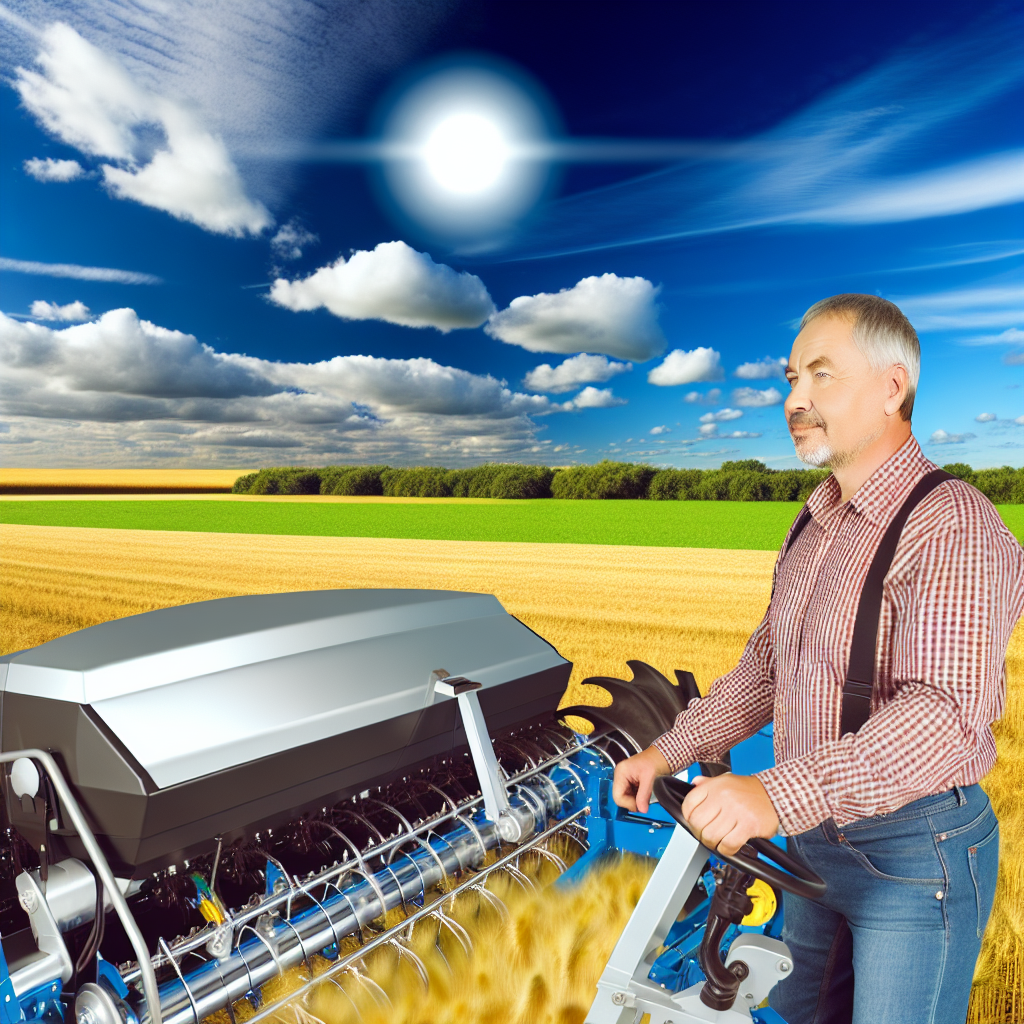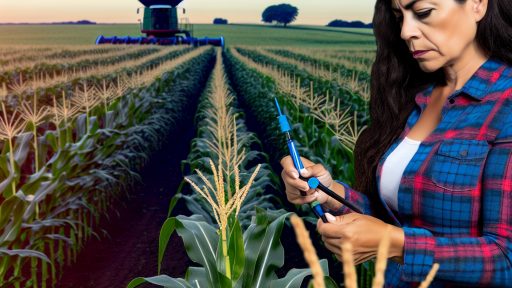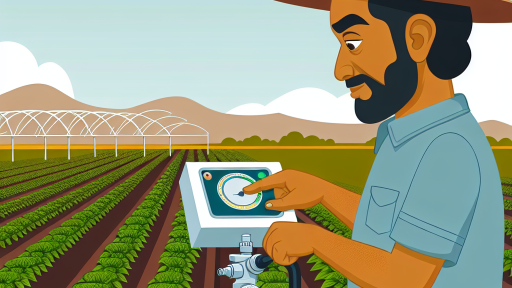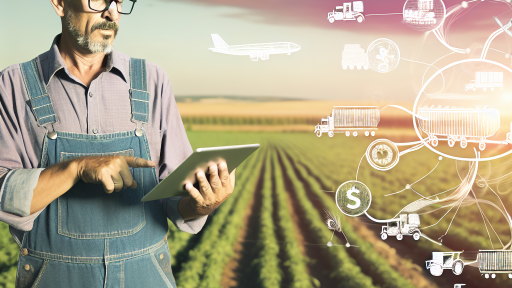Introduction to Automated Machinery in Agriculture
Automated machinery revolutionizes the agriculture industry.
Farmers increasingly rely on technology for enhanced productivity.
This shift significantly impacts both small and large farms.
Automation improves efficiency and reduces labor costs.
Moreover, it allows for more precise farming techniques.
Benefits of Automation
One primary benefit is increased efficiency in operations.
Automated systems can operate continuously without fatigue.
This round-the-clock capability maximizes output.
Additionally, automation minimizes human error.
With precise data analysis, farmers can make better decisions.
Types of Automated Machinery
Drones serve as valuable tools for monitoring crops.
They provide real-time data on plant health and soil conditions.
Additionally, autonomous tractors perform tillage and planting tasks.
Robotic harvesters can efficiently gather crops with minimal waste.
Each type of machinery contributes uniquely to farm productivity.
Transform Your Agribusiness
Unlock your farm's potential with expert advice tailored to your needs. Get actionable steps that drive real results.
Get StartedChallenges of Implementing Automation
Despite the benefits, some challenges persist.
The initial cost of automated machinery can be high for farmers.
Moreover, technical knowledge is essential for operation.
Farmers may face a learning curve when adopting new technology.
Lastly, maintenance of sophisticated systems requires additional resources.
The Future of Farming with Automation
Looking ahead, automation will continue to evolve.
Innovations will likely lead to even smarter machinery.
These advancements will make farming more sustainable and efficient.
In particular, data integration will drive decision-making processes.
The future of agriculture appears bright with ongoing advancements.
Historical Evolution of Farming Machinery
Early Innovations in Farming Tools
Farming has evolved significantly over centuries.
Initially, farmers relied on hand tools for cultivation.
Tools like plows and sickles represented early innovations.
These basic implements improved efficiency moderately.
Farmers could cultivate larger plots over time.
The Industrial Revolution’s Impact
The Industrial Revolution marked a turning point in agriculture.
New machinery emerged, enhancing productivity dramatically.
For instance, the steam engine powered tractors and harvesters.
These machines reduced labor demands significantly.
Consequently, farmers could manage larger farms with less effort.
The 20th Century and Mechanization
The 20th century saw widespread mechanization in agriculture.
Tractors became commonplace on farms around the world.
Farmers utilized combines to harvest crops efficiently.
This transition led to increased yields and reduced costs.
Showcase Your Farming Business
Publish your professional farming services profile on our blog for a one-time fee of $200 and reach a dedicated audience of farmers and agribusiness owners.
Publish Your ProfileHowever, it also introduced new challenges, such as soil degradation.
The Rise of Automation in Agriculture
In recent years, automation gained momentum in farming.
Precision agriculture technology is now at the forefront.
Farmers use sensors and drones to monitor crops closely.
These tools provide real-time data for informed decision-making.
As a result, crop management has become more effective.
Impact of Robotics and AI
Robotics and artificial intelligence are revolutionizing farming practices.
Autonomous tractors and robotic harvesters exemplify this trend.
These innovations streamline operations and maximize productivity.
Farmers can focus on strategic planning rather than manual tasks.
Moreover, they help address labor shortages in many regions.
Future Directions for Farming Machinery
The future holds great promise for farming machinery innovations.
Emerging technologies will likely focus on sustainability.
Developments in environmentally friendly farming equipment are underway.
Additionally, improved data analytics will enhance farming decisions.
Farmers can use these insights to optimize their practices.
Types of Automated Machinery Used in Farming
Tractors
Tractors play a central role in modern agriculture.
They perform various tasks from tilling to planting.
Furthermore, advanced tractors can now operate autonomously.
This technology increases efficiency significantly.
Harvesters
Harvesters streamline the process of gathering crops.
These machines can quickly and effectively collect produce.
They minimize waste by ensuring maximum yield extraction.
Recent models feature onboard processing capabilities.
This allows for immediate sorting and packaging.
Drilling Machines
Drilling machines automate the planting of seeds.
They ensure precise seed placement and depth.
Moreover, they reduce labor intensity and time requirements.
Some drilling machines utilize GPS technology for accuracy.
Irrigation Systems
Automated irrigation systems improve water management in farms.
These systems deliver precise amounts of water based on need.
They can operate on set schedules or respond to moisture levels.
By optimizing water use, farmers enhance crop health.
Drones
Drones are becoming popular tools in modern farming.
They provide aerial views of crops for analysis.
Some drones monitor plant health and moisture levels.
This information aids in decision-making and resource allocation.
Robots
Robotic systems are now entering various farming sectors.
They perform tasks like planting, weeding, and harvesting.
Robots increase productivity while reducing the need for manual labor.
Showcase Your Farming Business
Publish your professional farming services profile on our blog for a one-time fee of $200 and reach a dedicated audience of farmers and agribusiness owners.
Publish Your ProfileThese machines often work in challenging conditions efficiently.
Livestock Management Systems
Automated systems assist in managing livestock effectively.
They can track animal activity and health metrics.
These systems help ensure optimal conditions for animal welfare.
Keeping accurate records aids in better herd management.
Find Out More: Wind Energy Applications to Enhance Farm Productivity
Benefits of Automated Machinery on Farm Productivity
Increased Efficiency
Automated machinery significantly increases operational efficiency on farms.
It reduces the time spent on various farming tasks.
Consequently, farmers can focus on strategic planning.
For instance, automated tractors and harvesters accelerate land preparation and harvesting processes.
This efficiency leads to enhanced yield and productivity.
Cost Savings
Adopting automated machinery can result in considerable cost savings.
Fewer labor hours translate to lower labor costs.
Additionally, automation minimizes human error, reducing material waste.
Farmers may also see a decrease in equipment maintenance expenses due to improved machinery design.
As a result, the overall cost of production decreases.
Improved Precision
Automated systems offer improved precision in farming practices.
For example, precision agriculture technology applies fertilizers and pesticides exactly where needed.
This targeted approach can increase crop yield and minimize environmental impact.
Moreover, machinery equipped with sensors can optimize planting distances and depths.
This enhances crop health and overall farm output.
Enhanced Data Collection
Automated machinery facilitates better data collection and analysis.
Farmers can track crop performance and soil conditions in real time.
This data helps in making informed decisions on crop management.
Furthermore, analytics can predict future yields and improve strategic planning.
As a consequence, farmers become more adept at managing their resources.
Labor Shortage Mitigation
The agricultural sector faces an ongoing labor shortage.
Automated machinery addresses this challenge effectively.
By reducing the dependency on manual labor, farms remain productive.
This solution ensures that essential farm operations continue smoothly.
Additionally, automation can attract younger generations to the industry through advanced technology.
Increased Yield Consistency
Automated machinery contributes to yield consistency across crops.
This reliability enhances market competitiveness for farmers.
Automation standardizes farming operations which minimizes variability.
As a result, farmers can produce high-quality crops, meeting market demands.
Consistency aids in maintaining customer relationships and satisfaction.
Explore Further: Automated Machinery Streamlining Sustainable Farming Techniques
Challenges and Limitations of Using Automated Machinery
High Initial Costs
Investing in automated machinery often requires significant financial resources.
Many farmers face challenges in acquiring advanced technology due to these costs.
Additionally, maintenance and operation expenses can add to the overall investment.
Showcase Your Farming Business
Publish your professional farming services profile on our blog for a one-time fee of $200 and reach a dedicated audience of farmers and agribusiness owners.
Publish Your ProfileTechnical Knowledge Requirements
Using automated machinery demands specialized knowledge and skills.
Farmers must understand how to operate and troubleshoot complex equipment.
Furthermore, ongoing training is essential to keep up with technological advancements.
Dependence on Technology
Automated machinery introduces a level of dependency on technology.
Technical failures can disrupt farm operations and lead to production losses.
In such cases, farmers may experience delays in critical tasks like planting or harvesting.
Adaptation to Varied Conditions
Some automated systems struggle to adapt to changing environmental conditions.
Inconsistent weather patterns can affect machinery effectiveness and efficiency.
Thus, reliance on automated solutions may hinder responsiveness to urgent agricultural needs.
Integration Challenges
Integrating new automated machinery with existing systems can be complex.
Farmers may encounter compatibility issues between various technologies.
Such integration hurdles can lead to operational inefficiencies and wasted resources.
Social Implications
Automation can lead to job displacement in rural communities.
As machinery replaces manual labor, tensions may rise among local workers.
Moreover, this shift can impact the economy and social fabric of farming regions.
Gain More Insights: How Biotechnology Enhances Nutritional Value Of Crops

Success Stories of Automated Farming
Smart Irrigation at Green Valley Farms
Green Valley Farms implemented smart irrigation technology last year.
This system uses sensors to monitor soil moisture levels.
Consequently, they only water crops when necessary.
This approach reduced water usage by 30%.
Additionally, crop yields improved significantly.
Farmers reported a decrease in operating costs as well.
Automated Harvesting with Fresh Fields Co.
Fresh Fields Co. adopted automated harvesting machines last harvest season.
These machines efficiently collected ripe produce.
As a result, they increased their harvest speed by 40%.
This innovation also minimized crop damage during collection.
Moreover, labor costs decreased with fewer workers needed.
Precision Agriculture at Sunny Acres
Sunny Acres embraced precision agriculture technology.
This approach integrates GPS and satellite imagery.
Consequently, they managed resources more effectively.
Reports show they achieved a 20% increase in overall productivity.
Farmers also noticed better weed control and improved soil health.
Case Studies Showing Diverse Applications
Automated machinery benefits a wide range of farming sectors.
For instance, orchards utilize drones for crop monitoring.
These drones identify plant health and pest activities early.
Additionally, livestock farms use automation for feeding and monitoring.
This leads to healthier animals and optimized feed usage.
Community Impact and Economic Benefits
Automated farming not only boosts productivity but also helps communities.
Increased efficiency leads to lower food prices.
Additionally, these practices enhance local economies.
Showcase Your Farming Business
Publish your professional farming services profile on our blog for a one-time fee of $200 and reach a dedicated audience of farmers and agribusiness owners.
Publish Your ProfileMore farms investing in technology stimulate job creation.
Ultimately, better productivity fosters sustainable farming practices.
See Related Content: Choosing The Right Farm Management Software For Your Farming Needs
Future Trends in Agricultural Automation
Increased Adoption of AI and Machine Learning
Farmers increasingly embrace artificial intelligence technologies.
These tools analyze crop health and optimize yields effectively.
Moreover, machine learning algorithms predict weather patterns accurately.
This data-driven approach enhances decision-making on farms.
As a result, farmers can reduce waste significantly.
Development of Autonomous Equipment
Autonomous machines continue to revolutionize crop management.
Robots now plant, monitor, and harvest crops with precision.
These innovations save time and labor costs for farmers.
Moreover, they minimize soil compaction and improve efficiency.
Ultimately, growers enhance productivity and profitability.
Integration of IoT in Farming Practices
The Internet of Things plays a crucial role in agriculture.
Sensors placed in fields collect real-time data about conditions.
Farmers use insights from this data to make informed choices.
This leads to more effective water and fertilizer usage.
Consequently, farmers see improved crop yields and resource management.
Sustainability and Resource Efficiency
Future automation trends emphasize sustainability in farming.
Technologies are designed to reduce chemical usage and waste.
This shift helps conserve natural resources for future generations.
Additionally, precision farming methods contribute to environmental health.
Farmers adopting these practices enjoy long-term benefits.
Collaboration with Tech Companies
Farmland management increasingly involves partnerships with tech firms.
These companies bring innovative solutions and expertise to agriculture.
Such collaborations enhance productivity and efficiency on farms.
For instance, AgriTech firms develop tailored software for farmers.
Farmers benefit from systems that integrate seamlessly with machinery.
Emphasis on Data Security and Privacy
As automation becomes prevalent, data security gains importance.
Farmers must protect sensitive information from potential breaches.
Consequently, data privacy measures will be crucial in technology adoption.
Farmers will need to stay informed about best practices.
This ensures their operations remain secure and efficient.
Impact of Automated Machinery on Labor Workforce in Agriculture
Changing Roles of Farm Workers
Automated machinery is transforming the roles of farm workers significantly.
Farmers now rely more on technology than manual labor.
This shift allows workers to focus on more complex tasks.
Additionally, automation increases efficiency in daily operations.
Reduction in Labor Demand
As automation rises, the overall demand for labor decreases.
Many traditional roles are becoming redundant due to machines.
For example, tasks like planting and harvesting can now be automated.
Showcase Your Farming Business
Publish your professional farming services profile on our blog for a one-time fee of $200 and reach a dedicated audience of farmers and agribusiness owners.
Publish Your ProfileConsequently, fewer workers are needed on farms.
Upskilling of the Workforce
Despite reduced labor demand, there is an emerging need for skilled workers.
Laborers must now learn to operate and maintain advanced machinery.
This requires investment in training and education programs.
Moreover, adapting to new technologies can advance workers’ careers.
Shifts in Job Opportunities
The rise of automated machinery creates new job opportunities.
Positions in machinery operation and technology maintenance are increasing.
Furthermore, there is a growing demand for data analysis roles.
Workers now require a broader skill set to remain competitive.
Implications for Small Farmers
Small farms may face challenges adopting automated machinery.
High costs and limited access to technology can hinder progress.
Consequently, some small farmers may struggle to compete.
Support programs can help small farms integrate automation effectively.
Long-Term Workforce Trends
The agricultural workforce is evolving due to automation.
In the long term, we can expect a leaner, more skilled workforce.
Adaptability will be key for workers to thrive in this new landscape.
Ultimately, automation promises increased productivity and efficiency.
Additional Resources
Precision Agriculture Technologies and Factors Affecting Their …




